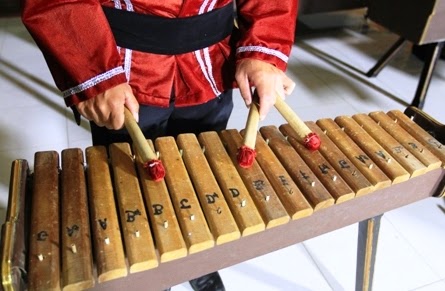Definition and explanation of the origin of traditional musical instruments Kolintang Minahasa, North Sulawesi. Kolintang also called kulintang. Kolintang word itself actually comes from the sound produced by the instrument at the time of the Tong low tone, high tone and time Ting Tang when issuing the middle tone. In the past when people want to play kolintang minahasa them they say "Maimo Kumolintang" (Let air TongTingTang) of habit that is named Kolintang instrument.
History
Originally kolintang musical instrument consists of several pieces of wood placed side by side on the second leg of his players with a sitting position on the ground, with both legs stretched out straight ahead. As time goes on legs player replaced with two banana trees, or sometimes replaced with a rope like arumba of West Java. While the use of crates sesonator started Diponegoro is in Minahasa (tahun1830). At that time, supposedly equipment gamelan and xylophone participated brought by his entourage.
Function
Kolintang formerly used in rituals associated with the worship of the ancestors. However, the inclusion of Christianity in Minahasa make this instrument is no longer used in the traditional rituals.
Development
Kolintang began to develop after World War II and resurfaced pioneered by Nelwan Katuuk (constituting a kolintang tone according to the arrangement of the universal musical tones). At first only consists of one Melody by arrangement diatonic, with a distance of 2 octave tone, and as accompanist used tools "string" like a guitar, ukulele and stringbas.
1954 kolintang already made 2½ octaves (still diatonic). In 1960 already reached 3 ½ octaves with one tone crotch, naturel, and 1 mol. Basic tone is still limited to three key (Naturel, 1 mol, and one crotch) with a distance of 4 ½ octave tone of F s./D. C. And development continues kolintang good music quality tools, extension tone spacing, shape crate resonator (to improve the sound), as well as appearance. Currently Kolintang made already reached 6 (six) with chromatisch full octave.
How Wields/Stick Kolintang
Stick kolintang has its own number and the number is generally holding stick kolintang can be done in the following way:
- Stick no. 1 Always on the left hand
- Stick no. 2 In the right hand (the thumb with the index finger)
- Stick no. 3 In the right hand (between the middle finger to the ring finger)-order batsman no. 2 freely movable over and away from no. 3, in accordance with the desired accord. And how to hit adjusted to the beat and rhythm desired, and each tool has, certain characteristics corresponding functions within accompany a song. On tools and instruments Bass Melody generally only use two sticks, making it easier and comfortable in the hand.
Previously,
kolintang consists of only one melody containing an array of diatonic,
with a distance of two octaves tone. As an accompanist, used stringed
musical instruments such as guitar, ukulele and bass. But in 1954,
kolintang already have two and a half octaves tone range and still have a
diatonic composition. In 1960, growing again up to three and a half
octaves with one sharp tone, natural, and 1 mol. Basic tone is still
limited to three key (natural 1 mol and one crotch), distance tone
evolved again into four and a half octaves from F to C.
The
development of musical instruments kolintang still going on, both in
terms of quality tools, expansion of distance tone, and shape of the
resonator crate.
